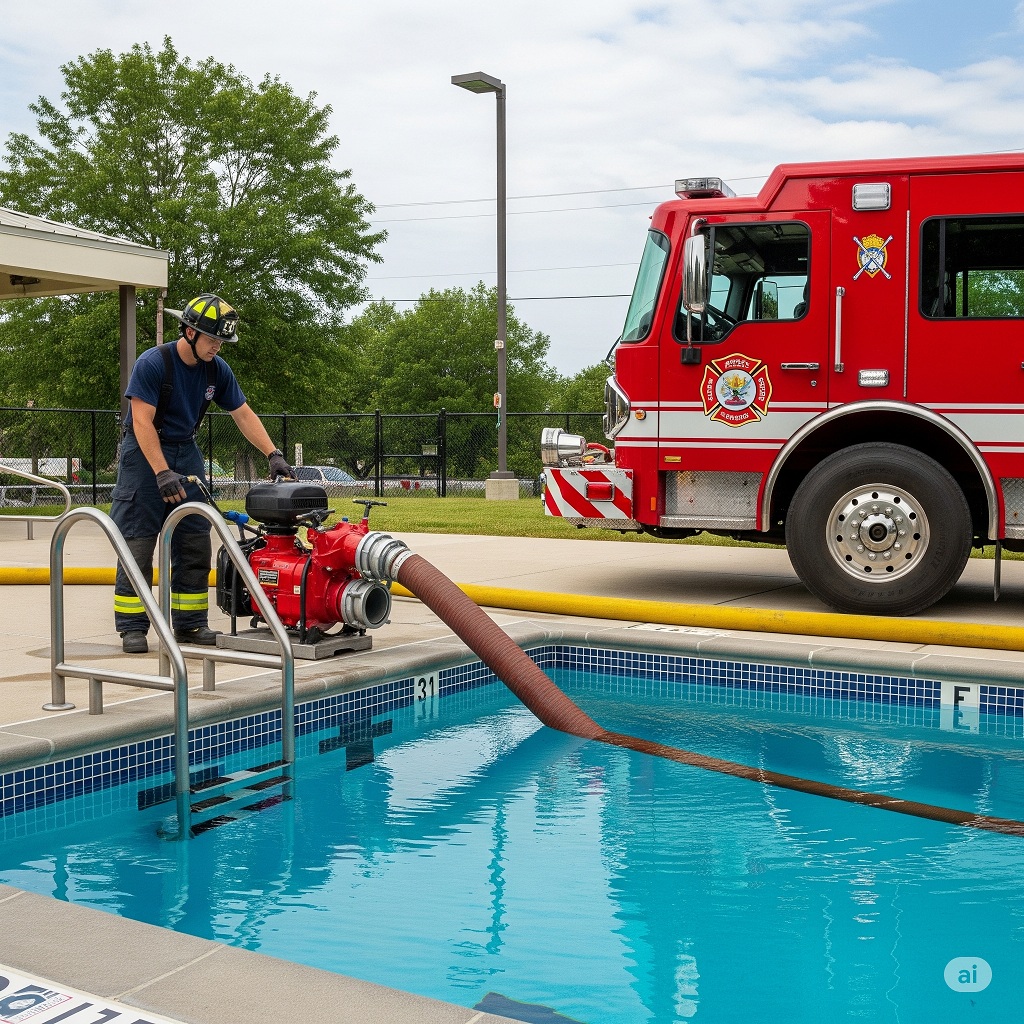
Imagine this: a fire breaks out, and you find yourself seeking refuge in a pool. But can you truly survive a fire by taking cover in the water? As a seasoned expert in fire safety, I’ll delve into the facts and myths surrounding this scenario.
Many believe that being in a pool during a fire is a foolproof escape plan. However, the reality may not be as straightforward as it seems. In this article, I’ll explore the science behind surviving a fire in a pool and provide you with the essential information you need to know.
Join me as we uncover the truth about whether a pool can truly serve as a safe haven during a fire emergency. Let’s separate fact from fiction and equip ourselves with the knowledge to make informed decisions in potentially life-threatening situations.
Key Takeaways
- Jumping into a pool during a fire may offer initial relief from heat, but it is not a fail-safe method for survival due to the limitations of water’s heat absorption capacity.
- Smoke inhalation remains a significant concern in a pool environment during a fire, as toxic gases can accumulate near the water’s surface, impacting breathing even while submerged.
- Sheltering in a pool poses challenges such as limited protection from intense heat, risks of heat exposure, reduced oxygen supply, and potential hypothermia from prolonged water exposure.
- Best practices for maximizing safety in a pool during a fire include staying calm, covering nose and mouth to filter smoke particles, staying low to reduce smoke inhalation, maintaining a safe distance from pool edges, clear communication, monitoring surroundings, planning an exit, and following rescuer instructions.
Common Beliefs About Surviving a Fire in a Pool
When it comes to fire safety, it’s crucial to separate fact from fiction. One common belief that many people hold is that jumping into a pool during a fire is a foolproof way to stay safe. There are myths surrounding this idea that need to be dispelled to ensure people are well-informed in emergency situations.
Here are a few common beliefs about surviving a fire in a pool:
- Belief: The water will protect you from the flames.
- Belief: The pool will not reach a high temperature in a fire.
- Belief: Smoke inhalation is not a concern in a pool during a fire.
It’s important to delve deeper into these beliefs to understand the reality of the situation and make informed decisions in potential life-threatening scenarios.
Understanding the Science of Fire and Water Interaction
When it comes to surviving a fire in a pool, understanding the science behind fire and water interaction is crucial. Fire needs three elements to thrive: heat, fuel, and oxygen. When a fire occurs, it produces intense heat, which rises rapidly. As the heat continues to rise, it can easily overwhelm the cool layer of air above the water’s surface.
Water, on the other hand, is not a shield against extreme heat. While water has a high heat capacity, it cannot absorb unlimited amounts of heat. Jumping into a pool during a fire might provide temporary relief from the flames, but the intense heat can still pose a serious risk.
Additionally, the smoke produced during a fire can be just as lethal as the flames. Smoke contains toxic gases such as carbon monoxide that can be fatal in high concentrations. In a pool environment, the smoke can linger near the water’s surface, making it difficult to breathe properly even while submerged.
In essence, while water can offer some protection by reducing the heat exposure initially, it is not a fail-safe method for surviving a fire. Being aware of the limitations of using a pool as a refuge during a fire can help individuals make more informed decisions in emergency situations.
Challenges and Risks of Sheltering in a Pool During a Fire
Sheltering in a pool during a fire may seem like a safe idea, but there are important challenges and risks to consider:
- Limited Protection: While water can provide initial relief from heat, it’s essential to remember that pools do not offer complete protection from the intense heat produced by a fire.
- Heat Exposure: Despite the pool’s cooling effect, extreme heat can still impact individuals, especially from the radiant heat and smoke inhalation, which can be harmful even near the water’s surface.
- Limited Oxygen: The pool’s water surface may not provide a sustainable oxygen supply, and the air above the water can quickly become toxic due to smoke and gases produced by the fire.
- Hypothermia Risk: Prolonged exposure to water, especially in cooler temperatures, can lead to hypothermia, posing a different set of risks to those seeking refuge in a pool during a fire.
Understanding these challenges and risks can help individuals make more informed decisions during emergencies.
Best Practices for Maximizing Safety in a Pool During a Fire
When considering sheltering in a pool during a fire, there are best practices to maximize safety. Here are a few key points to keep in mind:
- Stay Calm: Remaining calm is essential in any emergency situation. Panic can cloud judgment and hinder decision-making abilities.
- Cover Your Nose and Mouth: By using a damp cloth or shirt, you can help filter out smoke particles and improve the quality of the air you breathe.
- Stay Low: Smoke tends to rise, so staying low to the water’s surface can help reduce smoke inhalation.
- Keep a Safe Distance: Maintain a safe distance from the edges of the pool to prevent accidental falls into the water.
- Communicate Clearly: If there are others with you, communicate clearly and keep each other informed about your well-being and any changes in the environment.
- Monitor Surroundings: Continuously assess your surroundings for any changes in heat levels, smoke density, or signs of the fire worsening.
- Plan Your Exit: Be prepared to exit the pool if the situation becomes too dangerous or if emergency responders arrive to assist.
- Follow Rescuer Instructions: If rescue teams arrive, follow their instructions carefully for a safe evacuation.
These best practices can help improve your chances of survival when seeking refuge in a pool during a fire.
Conclusion
Ensuring safety during a fire incident while in a pool is critical. By following key practices like staying calm, covering your nose and mouth, and maintaining awareness of your surroundings, you can increase your chances of survival. Remember to stay low, away from pool edges, and communicate effectively with others. Having an exit plan and adhering to rescuer instructions are vital for a safe evacuation. These strategies are designed to optimize your safety and well-being in the event of a fire emergency.
Pool Fire Survival Tips – (FAQs)
❓ Can fire actually happen near a swimming pool?
Yes. Poolside fires can occur due to flammable chemicals (like chlorine), electrical equipment, grills, heaters, or even nearby vegetation catching fire.
❓ Is it safe to jump into the pool during a fire?
In general, yes, jumping into the pool may provide temporary protection from flames or heat. However, this is not a guaranteed survival method, especially in cases of toxic smoke or electrical fires.
❓ Can pool water protect me from fire smoke?
No. Smoke inhalation is the biggest danger in a fire, and water won’t filter toxic gases. Staying submerged too long is also risky due to drowning.
❓ Should I stay in the pool if there’s a wildfire nearby?
No. Pools don’t protect from radiant heat or flying embers. If evacuation is possible, leave immediately. If trapped, the pool may be a last resort.
❓ What should I do if a fire breaks out near the pool area?
- Evacuate immediately if safe.
- Alert others and call 911.
- Avoid pool equipment or grills.
- If trapped, seek shelter behind concrete walls or use the pool as a temporary shield.
❓ Can pool chemicals catch fire?
Yes. Chlorine, bromine, and pool shock are oxidizers and can ignite or explode if improperly stored or contaminated with other substances.
❓ Are pool heaters a fire hazard?
Yes. Malfunctioning gas or electric heaters can overheat or spark fires. They should be professionally maintained and never left on unattended.
❓ What precautions should I take to fireproof my pool area?
- Store chemicals in a cool, dry, ventilated area
- Keep grills and heaters at safe distances
- Trim vegetation and clear dry debris
- Install a Class B fire extinguisher nearby
- Use GFCI outlets and waterproof electrical enclosures
❓ What’s the best fire extinguisher for pool areas?
Use a Class B or ABC fire extinguisher, as it handles flammable liquids and electrical fires—common around pools.
❓ Should I practice fire drills for pool parties?
Yes. Especially with kids or large gatherings, knowing exit routes, having extinguishers nearby, and training someone in basic fire response is crucial.
❓ Can lightning cause fires around pools?
Yes. Lightning can strike nearby trees, buildings, or equipment, sparking fires. Always exit the pool during storms and disconnect electronics.
❓ What are signs of fire risk near a pool?
- Strong chemical smells
- Frayed electrical wires
- Pool lights flickering or overheating
- Storage clutter near heaters or pumps
- Vegetation close to open flames or grills
